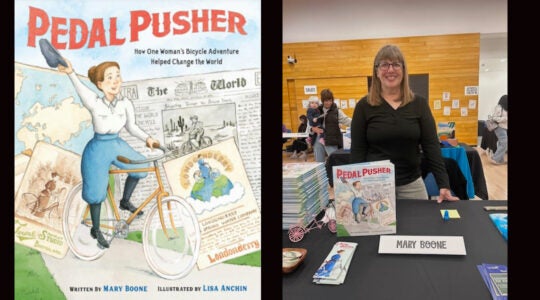SAN FRANCISCO (JTA) — It’s official: The newest American Girl doll is 9-year-old Rebecca Rubin, a Jewish-American girl who lives with her family on Manhattan’s Lower East Side in 1914.
The much-anticipated latest addition to the American Girl series of historical characters, Rebecca goes on sale May 31 along with six books about her life. No cheap date, she costs $95 with one book, or $118 if accompanied by the complete set.
Rebecca joins 14 other historical dolls in the series — from Kaya, a Nez Perce girl set in 1764, to African-American Addy, a Civil War doll, to World War II-era Molly, part of an Irish immigrant family. Her unveiling will include a tie-in at the Tenement Museum in New York City and a harbor cruise with “kosher-style” food, according to USA Today.
She’s a feisty girl, our Rebecca. In one book she rescues her cousin Anna from the top of a stalled Ferris wheel. In another she marches in a garment workers’ strike and gives an impassioned speech about labor rights. But she also cooks, crochets and dreams of becoming a movie star, just like a proper lass.
Rebecca lives with her Russian-immigrant parents, siblings and grandparents in a Lower East Side row house, just a step up from the tenements of Orchard Street, and they struggle mightily to save boat fare to bring more family over from the Old Country.
The Jewish blogosphere has been floating guesses about her name, release date and details of her life for more than a year with an intensity that belied her insensate status. She is, after all, just a doll, albeit a soft-bodied, large and quite beautiful one. But Jews love history, especially their own, and Jewish parents hip to the American Girl formula of nicely made dolls and well-written books about the period of American history they represent wanted a piece of their own people’s story to give their daughters.
“This is our history, right here in this doll,” says author Meredith Jacobs of Rockville, Md., host of “The Modern Jewish Mom” on The Jewish Channel.
Jacobs’ family is also from Eastern Europe, and her Uncle Saul’s dreams of becoming an actor were dashed by family pressure to enter the cantorate.
Jacobs plans to buy Rebecca and her books for her 13-year-old daughter, Sophie, even though she’s just beyond the target demographic.
“I want her to read the books and talk to my parents about our history,” Jacobs says. “I don’t think people who aren’t Jewish think about how big a deal it is for a mainstream doll company to make something Jewish.”
Rebecca confronts many of the same dilemmas faced by today’s American Jewish children as they navigate between tradition and modernity. In “Candlelight for Rebecca,” her teacher asks the class to make Christmas centerpieces, and Rebecca agonizes over what to tell her parents. In “Meet Rebecca,” she asks her father, an observant Jew who keeps kosher, why he opens his shoe store on Shabbat. (They need the money, he explains).
Children’s author Jacqueline Dembar Greene penned the six books about Rebecca’s life, basing some of the stories on her own family’s history. She quizzed her mother-in-law about the correct usage of certain Yiddish words and her 92-year-old father about his memories of riding the Ferris wheel at Coney Island.
Greene’s mother worked as a stitcher in a garment factory in Hartford, Conn., much like the one where Rebecca’s uncle and cousin suffered two decades earlier.
“Nothing had changed,” Greene says. “She told me about the bosses walking up and down yelling at the workers, about being locked in even though it was totally illegal. They weren’t allowed to talk or hum; they were timed when they went to the bathroom.”
Even the Christmas story came out of her own experience. Greene was in third grade in the 1950s when her teacher asked the class to make Christmas decorations.
“I brought mine home and burst into tears,” she recalls. “My wise, wise mother said, ‘I bet Mrs. Crocker would love it.’ ”
Mrs. Crocker was a widowed neighbor, much like the widower Mr. Rossi in Rebecca’s book, whom the fictional character gives her own Christmas decoration.
“I gave it to her,” Greene says, “and walked home feeling proud as punch.”
JTA has documented Jewish history in real-time for over a century. Keep our journalism strong by joining us in supporting independent, award-winning reporting.





